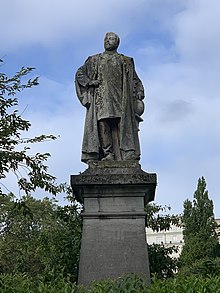Alphonse François Renard
[1] In 1870 he entered the Jesuit Training College at the old abbey of Maria Laach in the Eifel, and there, while engaged in studying philosophy and science, he became interested in the geology of the district, and especially in the volcanic rocks.
[1] In 1874 he became professor of chemistry and geology in the college of the Belgian Jesuits at Leuven, a few years later he was appointed one of the curators of the Royal Natural History Museum at Brussels, and in 1882 he relinquished his post at Louvain.
He was known as the Abbé Renard; but, as remarked by Sir A. Geikie, as years passed, the longing for mental freedom grew ever stronger, until at last it overmastered all the traditions and associations of a lifetime, and he finally separated himself from the church of Rome.
In later essays and papers he dealt with the structure and mineral composition of many igneous and sedimentary rocks, and with the phenomena of metamorphism in Belgium and other countries.
The various rock specimens and oceanic deposits were submitted to him for examination in association with Sir John Murray, and their detailed observations were embodied in the Report on the Scientific Results of the Voyage of H.M.S.
